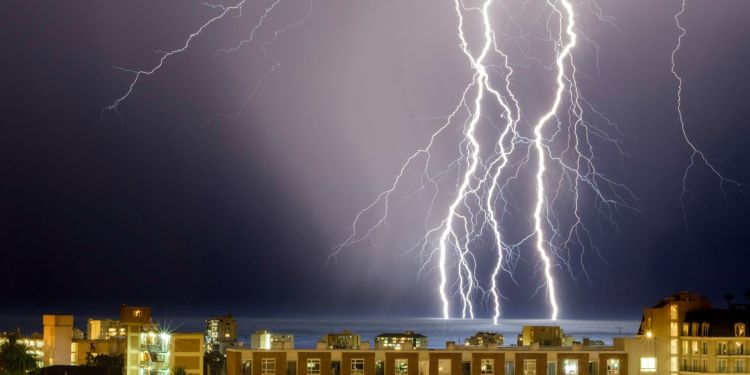Southern Africa hosts first ‘testbed’ to improve early warning of thunderstorms

Leading weather scientists and practitioners from the UK, South Africa, Zambia and Mozambique have commenced a two-week “testbed” to improve early warnings for severe thunderstorms in Southern Africa.
Southern Africa remains a region prone to extreme weather, with hundreds of thousands of people and livelihoods put at risk every year.
The region is expected to experience an increase in storms as climate change continues to take hold.
The testbed is part of the Weather and Climate Information Services Early Warnings for Southern Africa (WISER EWSA) project by the University of Leeds, the National Centre for Atmospheric Science and the Met Office in the UK.
Professor Doug Parker at the School of Earth and Environment is the Principal Investigator.
What’s happening in the testbed?
During the testbed, the first event of its kind in the region, real-time nowcasting and very short-range forecasting will be simulated.
Meteorologists, Scientists, Economists and User Engagement specialists will team up to create warnings of severe weather, deliver these to partnering user groups and co-evaluate the effectiveness of those warnings.
Forecasting activities are taking place at the offices of the Zambian Meteorological Department (ZMD) in Lusaka, with satellite sites at the South African Weather Service (SAWS) in Pretoria and the National Meteorology Institute Mozambique (INAM) in Maputo.
Related community engagements – an equally crucial aspect of the testbed – are taking place in Kanyama, west of Lusaka; Katlehong, south-east of Johannesburg; and Boane in southern Maputo.
On Wednesday 7th February, meteorologists, scientists, economists and user-engagement specialists are invited to join the in-person and online engagement day.
The day will play a crucial role in fostering collaboration, knowledge exchange and meaningful interactions among stakeholders, experts and participants involved in the live severe weather forecast.
Outcomes for disaster risk reduction
WISER seeks to generate novel weather information and ensure that this is communicated and used for disaster risk reduction decision-making.
The EWSA project, on the other hand, will co-produce critical early warning alerts for and with urban populations.
This requires several elements including expanding capacity for nowcasting among National Meteorological and Hydrological Services in South Africa, Mozambique and Zambia; understanding the decision contexts of urban populations in order to set appropriate alert levels; and ensuring that the resulting co-produced early warning alerts reach the people who can use these to reduce risk.
Scheduled to run until Friday 9 February 2024, the testbed is the result of 12 months of preparation from the WISER-EWSA team. The insights gained from the exercise will inform the design and delivery of a second testbed scheduled for early 2025.
Remarking on the event, Chief Meteorologist: Forecasting and Research in the Ministry of Green Economy and Environment, Mr Felix Imbwae, said: “Nowcasting offers a way to complement traditional weather forecasts by using real-world observations to increase our confidence in how the weather will change over the next few hours. Zambia Meteorological Department is proud to have the opportunity, with the National Meteorological Institute in Mozambique and the South African Weather Service, to be among the first meteorological services in Southern Africa that have capacity to generate this novel form of weather information for our citizens.”
The time to develop effective Early Warning Systems (EWS) is now.
South Africa’s Permanent Representative with the World Meteorological Organisation (WMO) and SAWS Chief Executive Officer, Mr Ishaam Abader, explains how the testbed ties in with the United Nations’ Early Warnings for All initiative.
“We are answering the clarion call that has already been issued. As Africa, we remain largely unguarded in so far as natural hazards are concerned. Failure to act with the necessary speed in these circumstances may result in untold devastation as we have already witnessed. The time to develop effective Early Warning Systems (EWS) is now,” Mr Abader said. “Only quick and decisive action will ensure that we too are protected from hazardous weather, water or climate by the end of 2027. This testbed is a critical part of that action.”
Economists working on the project are also looking at the value chain of Early EWS in participating countries to ensure that the investments are made where they create the most value and benefit for the people. The aim is to create a sustainable model for producing weather warnings that is accessible to diverse urban communities, in particular including women and people with disabilities.
Sustainable, long-term solutions
Professor Doug Parker, who is a senior meteorologist at the University of Leeds and the National Centre for Atmospheric Science (NCAS), stresses the need to ensure that solutions are sustainable.
“Short-range storm forecasts and nowcasts save lives and property, but they can be complex and relatively costly to generate. For the systems to be sustainable, it is essential that we identify and demonstrate business models for this kind of forecasting, so that African agencies can deliver the services long-term,” Professor Parker said.
“Building on our experience in other parts of Africa, and worldwide, we aim to demonstrate how government, the private sector and philanthropic funding can provide the resources needed to maintain life-saving services in Southern Africa.”
According to the Head of the World Weather Research Programme at the WMO, Dr Estelle de Coning, solutions developed in the WISER EWSA testbed will be applicable in other countries too.
“The Secretary-General of the United Nations announced the Early Warnings for All initiative in 2022 and the African continent was identified as one of the regions which need early warnings the most,” Ms De Coning explained.
“The WISER EWSA project demonstrates how early warnings on nowcasting and short-term forecasting time scales could be improved in southern Africa, and the practical engagement with users through the testbeds will make these ideas a reality – addressing the full value cycle, including users of this information.”




